I want to put more of myself into this blog, more of my relationship to horror. In my penultimate semester of college (I only completed my degree in April) I took an advanced nonfiction writing class that was focused on the lyric essay. We had to write two pieces, one playing with a conventional form (which I did as a piece called “Letters,” in which I wrote to some personal heroes of mine, most of whom are fictional– don’t worry, I’ll put it up here, eventually) and another following an invented form that fit the piece itself. Due to the notable size of the latter work, I will be posting it in sections, probably three. I feel like it is perfect for this blog because it was an exploration of my attraction to darkness, to horror. I followed several threads throughout the piece: narrative of my interactions with the horror genre, self-reflection, descriptions of the fictional town of Silent Hill and its related works, and excerpts from part 2 of my horror-novel-in-progress, Dark Art (part 2 being titled “The Brightest Nightmares”). I hope you enjoy this first section. Also, don’t hesitate to post criticism or notations of errors, this is a work that deserves more polish, and I really hope to get it published.
“Horror is truth, unflinching and honest.”
-Kealan Patrick Burke
The creature stands tall, taller than most men, well over six feet in height. Muscled, scarred, looming, and yet his posture suggests indifference. That somehow is far worse than obvious menace.
His apparel is a long, stitched up robe with no arms. It’s fabric’s color is nearly indeterminable as it is totally filthy– covered with dirt and gore. The most prevalent feature is his mask, his long metal pointed pyramid-shaped helmet that totally hides any humanity the miscreation could possess. The metal of the pyramid is black mesh, rusted and blood-scabbed, the long point coming down to mid-chest. There is a long bolt in the back that secures the iron executioner’s cowl to his skull.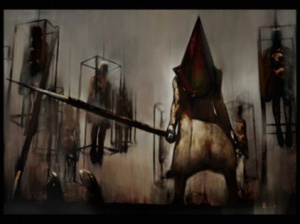
With one hand he holds a Great Knife or a long spear. The knife he drags on the ground; the screech of steel on cement heralds his approach.
He is Self-Loathing and Self-Fear. He is Guilt made manifest for those he plagues.
He haunts James Sunderland through the town of Silent Hill for smothering his cancer-riddled wife. In the neighboring town of Shepherd’s Glenn, he is Adam Shepherd’s guilt for breaking a pact to sacrifice his first son.
He is called the Red Pyramid, or Red Pyramid Thing, or simply Pyramid Head.
–
My Sunday school teacher reads from The Book of Mormon aloud, “But charity is the pure love of Christ, and it endureth forever; and whoso is found possessed of it at the last day, it shall be well with him.” He proceeds with his own thoughts: “It is absolutely important that we learn to love others– even total strangers– the same way Christ loves them. The best way to learn to love others is by serving them. So, help around your house, even when you are not asked to. Participate in service projects. Service is one of the best ways to follow Jesus Christ and become more like him. His whole life was dedicated to serving others– healing the sick, raising the dead– and His Atonement was the greatest act of love and service, sacrificing himself and suffering for everyone’s sins.”
I sit and nod. I have heard this lesson, worded slightly differently, dozens of times before, even though I am just twelve or thirteen. The message being taught is something I believe.
I can’t help but wonder, though, why a few weeks ago we talked about having good friends– and avoiding having friends with those who do things that don’t align with what the church teaches. I understand not joining with friends in making poor decisions, but how Christlike would it be to disassociate myself from friends just because they don’t have the same perspective of morality as I do?
Didn’t Christ spend his time among the sinners?
–
My phone rang at 11:32 that night. Verrick. He hadn’t called for help on a case in a year and a half, just a few months after I left the business.
I sat up, pulled on a pair of jeans, turned by habit to inform my wife I was going out. Felt a stab of pain remembering that she was no longer there.
I reached into my pocket for a cigarette. No carton. Remembered that I had quit last year.
Verrick sounded unnerved. That scared me– he wasn’t an easy man to unnerve, and it took far more for him to swallow his pride and call his old partner. He blamed me for his lack of success after I left.
The pay must have been monumental.
I found my shirt and coat and headed to my apartment door, which creaked loudly. I swore at it, then heard my little daughter’s voice come from her bedroom, “Daddy, where are you going?” Golden curls bounced as her little head popped up, gray eyes peering into the darkness.
“I gotta go help an old friend, angel. Be back in about an hour.”
“I don’t want you to go.” Heartbreaking.
“Don’t worry, honey, I’ll be back. I’ll lock the door so you’ll be safe. Go to sleep.” I hated myself for leaving her home alone like this. God damn life as a single parent.
She whimpered as I stepped out the door. “I love you, daddy!” I heard her muffled yell as I locked it securely, all three locks. I smiled, let my thoughts wander to the dream that had been interrupted by Verrick’s call. It was about my wife. She was still alive. It was my very last good dream.
–
When I was in the third grade I went over to a friend’s house and played PlayStation with him, primarily the game Oddworld, a quirky sidescroller. Shortly before the time set for my mom to pick me up, the friend popped in Resident Evil, a game featuring a mansion full of zombies and similar monsters, telling me that I would like it. The first combat experience opened with a cutscene featuring a zombie eating a decapitated body with the head laying across the room, face frozen in screaming agony. The image shocked and deeply frightened me. I backed against a wall and refused to let him show me more. Subsequently, I had vivid nightmares almost every night for three months.
My mother never let me play there again.
–
My uncle, Dallin, has always influenced my interests. It makes a lot of sense– he’s just four years older than me, so he seems much more like an older brother than my mother’s brother. On one visit to my grandparents’ house in Arizona when I was fifteen he showed me a couple of movies and two of his favorite video games– Half-life 2 and Resident Evil 4,we played each for an hour or two. I was pleasantly surprised with each of them, relishing the adrenaline rush of fighting off zombies and other twisted monsters.
Shortly after that experience, I saw a part of the film The Green Mile on TV. It was brilliant, and the supernatural elements of the plot caught me off guard. I interrogated my dad, who had been watching it, but found his explanation of the parts I missed lacking, so I turned to Wikipedia to learn more about it. I learned that The Green Mile was originally a serial novel by Stephen King. Immediately I sought out the book, and found myself deeply impressed with his powerful writing style. Intrigued, I began to dive into a wide variety of his works, including darker novels like ‘Salem’s Lot and The Shining. I soon decided that I was going to read all of his books because I loved how powerfully evocative his writing was, and that it dealt with darkness in a way that I had not found in any other genre of writing before, expressing a fear of the unknown and of darkness, while still being willing to appreciate its complexity. Villainy was no longer just about power, some evil king wanting to conquer a land, but rather it was often very familiar. Very human.
–
Yellow. Bright, vivid yellow spattered all over the floor, on the walls, the ceiling. The world seemed to scream yellow. I inhaled the acrid stench of yellow, tasted a bitter yellow bite on my tongue.
I turned around and retched until I could only dry-heave. I stared at the puddle of bile and felt surprised and relieved that it wasn’t that god-awful yellow.
Shaking, I forced myself to face the room again. It was nauseating, but I managed to suppress more spasmodic vomiting. As my eyes moved across what lay before me, I took in other vivid colors. Greens and blues and oranges and violets splayed unnaturally over everything within sight. Every color but red. Well, there was a little of it, browning as it dried, but with what was decaying on the floor, there should have been red. Lots of red.
In the center of the room was a corpse. First glance showed a simple stiff, like you’d see dead of natural causes or a poisoning or the like. When I walked closer I saw the corpse wasn’t regular at all. The head was facing the wrong direction. So were the arms and legs. Small wonder the face was frozen in the most disturbing scream I’ve ever seen. Oh, and the skin was paler than normal, like there was no blood in the body at all.
When I realized just how awful the body was, I looked away to push away my resurfacing need to vomit. My eyes fell upon Verrick, in his distinctive topcoat and fedora, standing in a corner, looking as dazed as I was. I used to have a hat almost identical to his. My loving wife used to make quite a few jokes about our clothing, referencing to pulp detective stories and film noir. She loved to call me Sam Spade or Bogie. God, I miss those days.
–
I was able to find things in horror that I hadn’t been seeing in the other genres I was interested in– the genres my parents approved of.
With the exception of a lot of famous older horror writing, stories by Poe or Lovecraft or Stoker, I didn’t tend to see the typical good versus evil motif. Things were more complicated than that. Characters began to become more real. Nobody was just good or just bad, every person had their flaws or redeeming qualities. Even monsters and ghosts tended to be more complex than incarnations of pure evil. They had their motivations and ideologies, even if they were fueled with twisted logic.
For example, in pretty much any movie involving zombies the real, driving conflict of the film is internal among the survivors. Yes, zombies kill people, but it is almost always because of the decisions and flaws of the humans. Humanity is the problem, not the masses of undead. The horrifying monsters are no more the villain than a natural disaster is. The villain is human weakness, or of trying to live only by ideals in an imperfect (or downright hellish) world. Virtue can become just as deadly as vice.
In horror I was able to find a wide spectrum of exploration of the moral grays that fill real life, and it began to make me more complex, more thoughtful. I became more able to find ways to live what I believed in.
–
I’m fifteen, at a family reunion, shooting shotguns at clay pigeons with my dad, uncles, and some cousins.
I am disappointed with my shotgun. It is an accurate weapon, but it’s just a 20-gage while almost every other gun is of the more powerful 12-gage. It’s also a single shot, while the weapons my relatives own can fire again and again, the shotguns all semi-automatics. My mind starts to piece together an idea for a story about a master gunman who uses cheap, lower-quality weapons with great skill, “Surely a true master sculptor can create a masterpiece with any chisel. A true master gunman can kill with every shot, no matter what type of guns’ trigger was pulled.”
That evening, I pull out my notebook and write the story in a single session. The story develops in an unexpected way– instead of a hero sniper, like I anticipated when I sat down, the story becomes about a robber who creates a slaughter in the bank. Even more surprising, the story has a supernatural twist ending, a “Twilight Zone ending” as I like to call it, in which the robber only steals a painting from a safe deposit box on which is the “same scene of carnage” as the massacre he just created. I title the piece “The Cruel Masterpiece of Gunfire.”
I don’t know it yet, but there is a dark, masked figure watching my efforts from a distance.
–
In high school a good portion of my friends are not LDS, and a number who are do not live as the church teaches, spending weekends drinking or engaging in sexual activities at the ends of dates. I do not participate in any of their wilder activities, but I am able to look past what I perceive as faults or sinful behavior to see good, sincere people who I relate with. True friends.
I try to be there for them, even if others do not. Two of my closest friends (one of whom I had dated) struggle with understanding the lessons they had been taught in church, and I try to make it clear that if there is anything that they need help understanding, I am available to help. Even though my offers to help are rarely accepted, I do not stop offering.
I care deeply for my friends, even though they make different decisions than I do. Maybe in part because they make different decisions, because they are more complicated. They are real, flawed people, like the characters in the books I read and the movies I watch and the games I play.
–
Verrick watched me with wide eyes. “Terrible, isn’t it? Lord, I’ve never seen anything like it in my life- in my whole career.” He lit a cigarette. I bit my lower lip to keep myself from bumming one off of him. “It’s like god-damned horror movie shit.”
“Hell, worse.” I didn’t want to, but I had to ask, “It isn’t paint, is it?”
“I wish to God it was. It glowed under a black light. I think it’s blood.”
“God.” I shivered. “Any idea on the cause of death? The neck snapping when the head got twisted or what?”
“I turned him over– there’s holes in the belly. All the vital organs were ripped out. Like gutting a fish. Looks like that happened first.”
I swore again, staring at his cigarette. “Are the guts still around?”
“No. Ah, hell. Let’s walk outside. I don’t want to be in here any more than I need to.” He brushed past me and through the doorway, nearly stepping in my vomit on the pavement. I followed. The cool night air was soothing.
“Any clues?”
“No. No imprints in the blood. I haven’t dusted for fingerprints yet. No signs of resistance from the victim, nothing.”
“So, what’s the job, exactly?”
“Gotta figure out who did it, why, how. This would be a hell of a job for an FBI crime lab.”
“So you called me.”
“Yeah. I didn’t know what else to do. I need the money.”
I coughed. “How much?”
“They’re paying twenty plus. And you should have seen the girl who hired me, a real class-act. Almost a short, blonde version of Annette.” Ah, there it was. Typical– he brought up my wife.
–
A new story idea comes powerfully, unbidden, while I’m driving. Not a concept, but text, almost like the story is already written somewhere, being read aloud in my mind. The story being told is about a man who has vivid, head-splitting brightly-colored nightmares, then goes into a hardboiled crime story.
When I get to my destination, I track down some paper and scribble down the words that are firing through my mind. By the next day the story has become disturbing, a detective and his ex-partner investigating a grisly murder where there is a mangled corpse in the middle of a warehouse with walls splattered with multi-colored blood. My stomach churns as I paint the gruesome scene, and yet I can’t stop. Unnerved, I push forward to discover where the plot of “The Brightest Nightmares” is heading.
The story rapidly flows into a document on my family’s desktop computer. The detective and ex-detective argue about their pasts and then–
I stare at the screen, not believing the words that have clumsily made their way onto the page: “My wife never came home. In her place, almost the same time I expected her home, were two police officers that told me they had terrible news. The love of my life had, along with many others, been gunned down at the bank by a robber.” I read it again. Again.
The story had connected itself to “The Cruel Masterpiece of Gunfire.” The “Twilight Zone ending” of the first story was no longer an ending.
It was a beginning. Of a horror novel.
A dark figure steps into the room where I am writing, dragging a long, blood-encrusted sword.
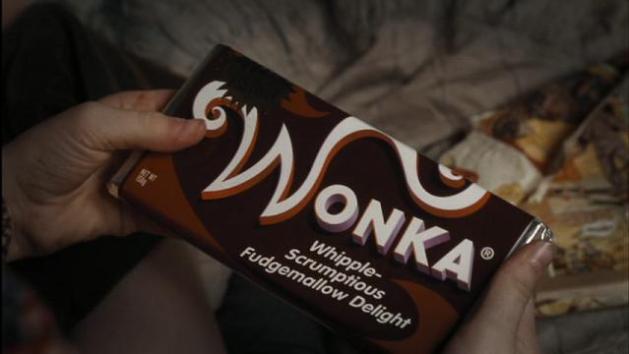
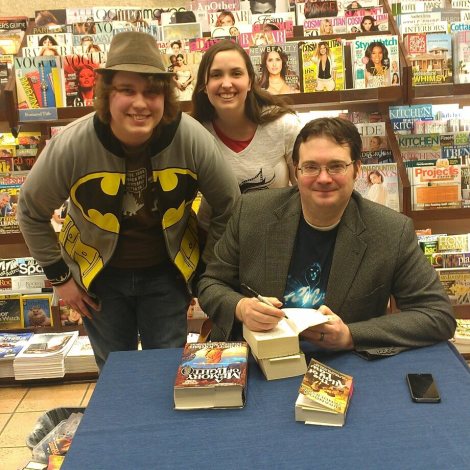
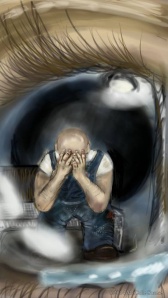 , but to see it in all of its awesome detail, follow the link to the story itself.
, but to see it in all of its awesome detail, follow the link to the story itself.
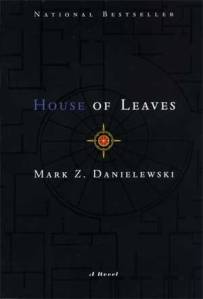
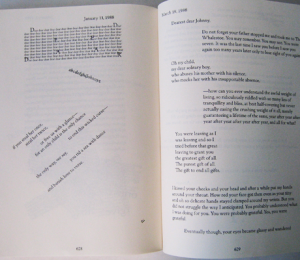 words are laid out on the page, or what color certain words are, as part of how the story is conveyed. The reading becomes very difficult at times to follow because of the novelist’s wildly experimental techniques, but as a reader you feel as though the novel is worth all of the time and effort that was necessary to put in to get through it.
words are laid out on the page, or what color certain words are, as part of how the story is conveyed. The reading becomes very difficult at times to follow because of the novelist’s wildly experimental techniques, but as a reader you feel as though the novel is worth all of the time and effort that was necessary to put in to get through it. As per tradition, I feel I should introduce myself. I am Nathaniel J. Darkish, an aspiring writer who is yet to be published. I recently completed a bachelor’s degree at Utah State University, majoring in English, emphasizing in creative writing.
As per tradition, I feel I should introduce myself. I am Nathaniel J. Darkish, an aspiring writer who is yet to be published. I recently completed a bachelor’s degree at Utah State University, majoring in English, emphasizing in creative writing.